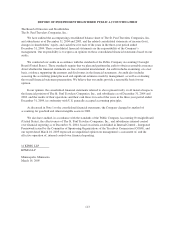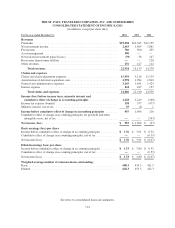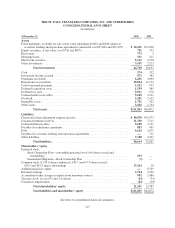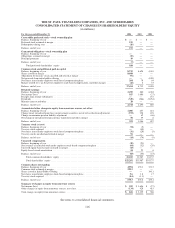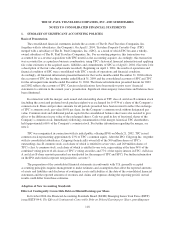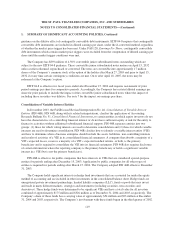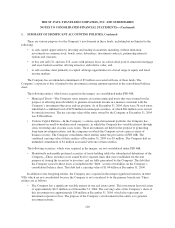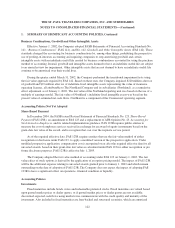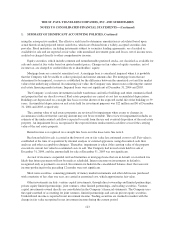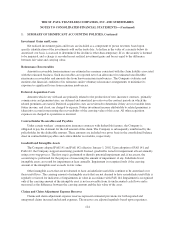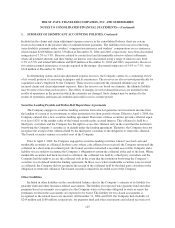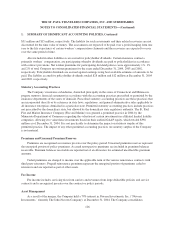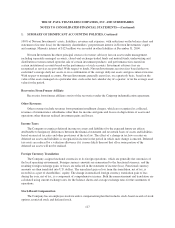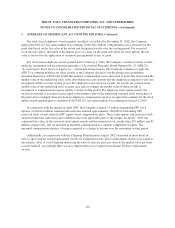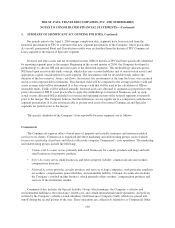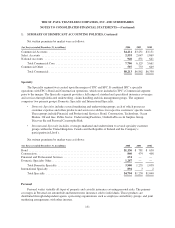Travelers 2004 Annual Report Download - page 133
Download and view the complete annual report
Please find page 133 of the 2004 Travelers annual report below. You can navigate through the pages in the report by either clicking on the pages listed below, or by using the keyword search tool below to find specific information within the annual report.THE ST. PAUL TRAVELERS COMPANIES, INC. AND SUBSIDIARIES
NOTES TO CONSOLIDATED FINANCIAL STATEMENTS—(Continued)
1. SUMMARY OF SIGNIFICANT ACCOUNTING POLICIES, Continued
• The Company also has a variable interest in Camperdown UK Limited, which SPC sold in December
2003. The Company’s variable interest results from an agreement to indemnify the purchaser in the
event a specified reserve deficiency develops, a reserve-related foreign exchange impact occurs, or a
foreign tax adjustment is imposed on a pre-sale reporting period. The maximum amount of this
indemnification obligation is $200 million. The fair value of this obligation as of December 31, 2004
was $44 million.
Accounting and Disclosure Requirements Related to the Medicare Prescription Drug, Improvement and
Modernization Act of 2003
On December 8, 2003, President Bush signed the Medicare Prescription Drug, Improvement and
Modernization Act of 2003 (2003 Medicare Act) into law. The 2003 Medicare Act introduces a prescription drug
benefit under Medicare Part D as well as a federal subsidy to sponsors of retiree health care benefit plans that
provide a benefit that is at least actuarially equivalent to Medicare Part D. On January 12, 2004, FASB issued
Staff Position FAS 106-1, Accounting and Disclosure Requirements Related to the Medicare Prescription Drug,
Improvement and Modernization Act of 2003 (FSP 106-1), which permits sponsors of retiree health care benefit
plans that provide prescription drug benefits to make a one-time election to defer accounting for the effects of the
2003 Medicare Act. FASB Staff Position FAS 106-2, Accounting and Disclosure Requirements Related to the
Medicare Prescription Drug, Improvement and Modernization Act of 2003 (FSP 106-2), was issued on May 19,
2004, supersedes FSP 106-1 and provides guidance on the accounting for the effects of the 2003 Medicare Act
for sponsors of retiree health care benefit plans that provide prescription drug benefits. FSP 106-2 also requires
certain disclosures regarding the effect of the federal subsidy.
The Company has concluded that the prescription drug benefits available under the SPC postretirement
benefit plan are actuarially equivalent to Medicare Part D and thus qualify for the federal subsidy under the 2003
Medicare Act. The Company also expects that the federal subsidy will offset or reduce the Company’s share of
the cost of the underlying postretirement prescription drug coverage on which the subsidy is based. As a result,
the estimated effect of the 2003 Medicare Act was reflected in the purchase accounting re-measurement of the
SPC postretirement benefit plan on April 1, 2004. The effect of this adjustment was a $29 million reduction (with
no tax effect) in the accumulated postretirement benefit obligation as of April 1, 2004 and a reduction of $2
million in net periodic postretirement benefit cost for the year ended December 31, 2004.
Accounting for Stock-Based Compensation
Effective January 1, 2003, the Company adopted the fair value method of accounting for its employee stock-
based compensation plans as defined in FASB Statement of Financial Accounting Standards No. 123, Accounting
for Stock-Based Compensation (FAS 123), using the prospective recognition transition alternative of FASB
Statement of Financial Accounting Standards No. FAS 148, Accounting for Stock Based Compensation—
Transition and Disclosure (FAS 148). FAS 123 indicates that the fair value based method is the preferred method
of accounting. The Company has elected to use the prospective recognition transition alternative of FAS 148.
Under this alternative only the awards granted, modified, or settled after January 1, 2003 will be accounted for in
accordance with the fair value method. The adoption of FAS 123 did not have a significant impact on the
Company’s results of operations, financial condition or liquidity.
121




